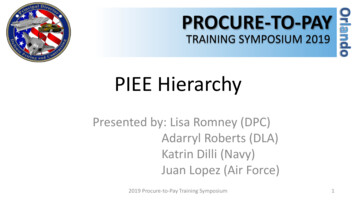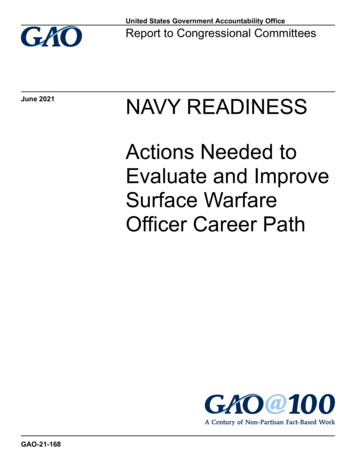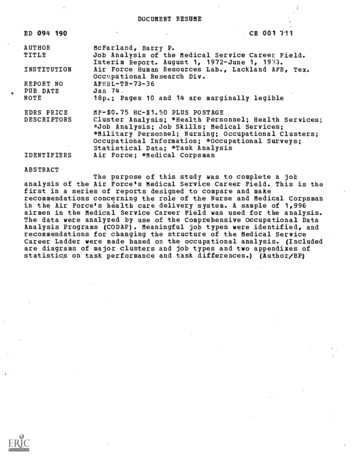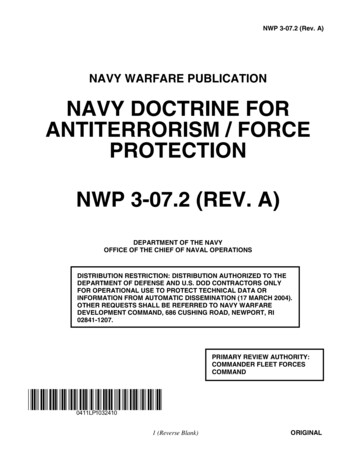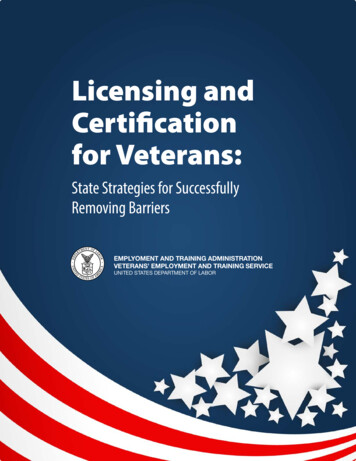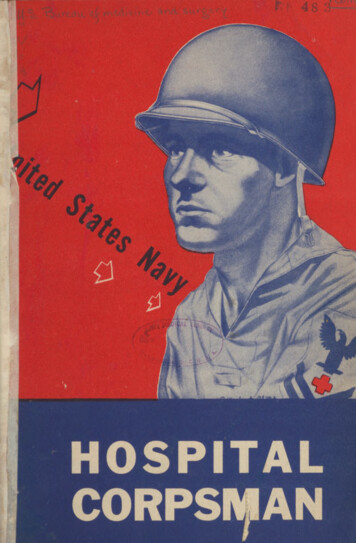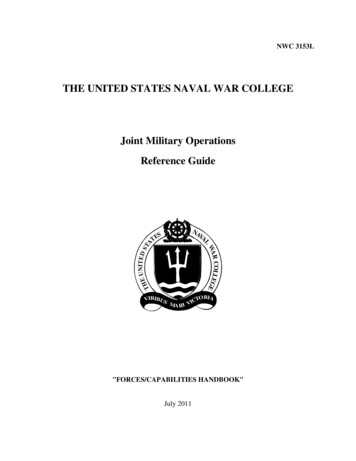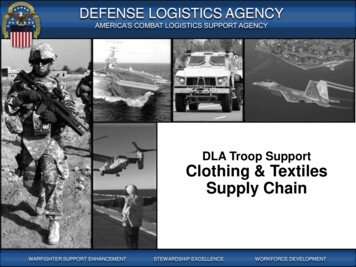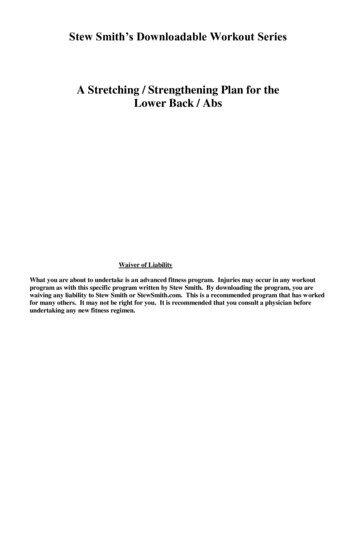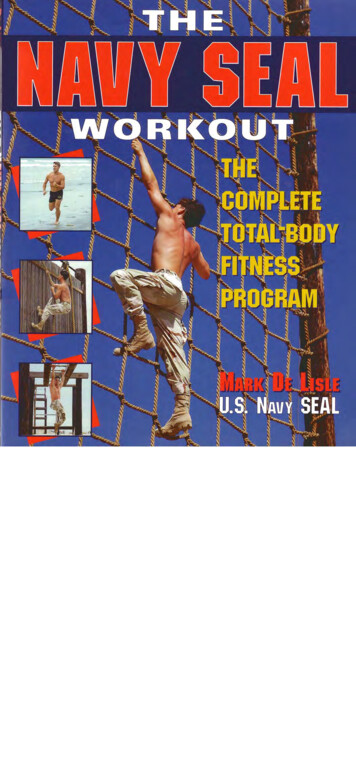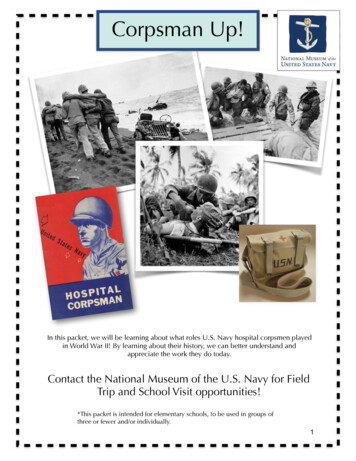
Transcription
Corpsman Up!In this packet, we will be learning about what roles U.S. Navy hospital corpsmen playedin World War II! By learning about their history, we can better understand andappreciate the work they do today.Contact the National Museum of the U.S. Navy for FieldTrip and School Visit opportunities!*This packet is intended for elementary schools, to be used in groups ofthree or fewer and/or individually.1
What is a corpsman?The U.S. Navy and the U.S. Marine Corps do not have medics, they have corpsmen. Navy corpsmen gettheir names from the U.S. Navy’s Hospital Corps. Established in 1898, the Hospital Corps gave the U.S.Navy the ability to give enlisted sailors formal medical training. Corpsmen assist doctors on board shipsand submarines, and some are attached to Marine units. When in combat, corpsmen are trained to runtowards the action to help the wounded, often risking their own lives to do so.During World War II, hundreds young men became corpsmen mostly by chance. Some even requestedcompletely different jobs! Many did not have any medical training or experience before enlisting in theU.S. Navy. That meant they had to learn everything from the ground up. After passing their U.S. Navytraining, they would move on to Hospital Corps school, where they learned things like first aid, anatomy,and hygiene. They would also learn how to operate medical equipment like x-ray machines. Finally,corpsmen would be assigned to U.S. Navy hospitals, ships, or Navy air centers to put these skills to use.A select few of these would then be sent to the Marines.Beginning in World War II, corpsmen who served with the Fleet Marine Force would go through bootcamp with the U.S. Marine Corps. This gives them the skills they need to act as a field medic on thebattlefield. They were also trained in combat skills to protect themselves and their comrades if necessary.In the field, these Fleet Marine Force (FMF) corpsmen helped provide emergency first aid to woundedMarines. By quickly disinfecting and bandaging wounds, treating burns, and setting broken bones,corpsmen helped ensure their buddies would survive the trip from the battlefield to a hospital ship.Corpsmen would often help lead the wounded back to aid stations, where Navy doctors could providemore intensive care. Wounded Marines would then be sent to a hospital ship, and finally a U.S. Navyhospital for recovery.Corpsmen serving in hospitals and on-board ships usually provided routine medical care, but weresometimes asked to preform medical miracles! Most famously, submarines on war patrols carried a welltrained corpsmen, but no doctor. While hunting for enemy ships, submarines cannot surface wheneverthey want to, and they are often far away from any friendly ships or ports to ask for help. During WorldWar II, hospital corpsmen had to preform emergency operations to remove a submariner’s appendixwithout the help of a licensed doctor three different times!Did you know?Navy corpsmen are often nicknamed “Doc”by the people they serve with.2
Corpsmen in WWIIIn wartime, both sides usually try to avoid purposely attackingmedical personnel. According to the Geneva Conventions, anydoctors, medics, nurses, or corpsmen are not supposed to carryweapons, and must display a red cross insignia on their person orhelmet to show they are a noncombatant.Guiding Question:Do you think you could be a NavyCorpsman? What skills would youneed to have to be a goodcorpsman?While these rules were usually respected in Europe, corpsmen serving in the Pacific quickly learned thatanything that showed they were a medic could put them at risk. The Japanese liked to target corpsmenand Army medics, as well as doctors. They knew if they hurt or killed someone with medical training,they wouldn't be able to help other wounded Marines or soldiers. They also knew that both Marines andsoldiers might be more willing to risk their lives to help save a corpsman or medic. Corpsmen servingwith the Marines were trained to use weapons just as well as a Marine and often carried firearms intocombat, even if they did not use them during battle. They wore the same uniforms as their Marinebuddies and tried to blend in as much as possible. This made it harder for the Japanese to tell who wasa corpsman and who was a regular Marine. On many occasions, corpsmen had to use weapons to helpprotect the wounded or themselves.Corpsmen in the Pacific also had to battle dangerous diseases like malaria, dysentery, and beriberi.They helped treat the diseases, and tried to prevent the spread of them by giving medicine to Marines.Some corpsmen were asked by their commanding officers to give talks about first aid and field medicineto groups of Marines before they went into battle. This helped Marines know how to keep themselvesand their buddies safe in case a corpsman couldn’t get to them quickly.Although most corpsmen saw combat with the Marines in the Pacific or on Navy vessels around theworld, many participated in amphibious landings in the European theater as well. They set up beach aidstations and provided first aid to wounded soldiers in North Africa, Italy, and Normandy.No matter where they served, corpsmen were trusted and relied on by their comrades. Some men wouldeven tell corpsmen their secrets and worries about the war and their lives back home. Corpsmen werealso trained to help treat “battle fatigue”, what we now know as Post Traumatic Stress. In places likeNormandy, the Philippines, and Okinawa, corpsmen would also do what they could to help civilianscaught in the middle of battles.Did you know?Atabrine helped prevent malaria, butthe pills tasted so bitter, many peoplehated taking them! Corpsmen wouldsometimes watch to make sure the pillswere actually being swallowed.3
UniformsWhen serving on a U.S. Navy ship or at a U.S. Navy hospital, corpsmenwore the same uniforms as other enlisted sailors. When serving with theFleet Marine Force, Corpsmen were given special permission to wearmany of the same uniforms as the U.S. Marine Corps with a fewmodifications. Buttons and stitching would be changed to subtly label acorpsmen as U.S. Navy personnel. This included combat uniforms andservice uniforms, with the exception of the USMC dress blues. This couldsometimes get corpsmen into trouble – members of the military police orofficers might not recognize them as a corpsman and expect them toreport to duty with different units!Corpsmen who assisted U.S. Army beach landings also occasionally wore Army issued clothing. Thishelped them blend in the same way wearing Marine uniforms on beaches in the Pacific. Depending on thesituation, they may have worn red cross arm bands or painted identifiers on their helmets to make it clearthey were medical personnel.Guess that Uniform!Can you guess when a corpsman might wear these uniforms? Fill in youranswers in the space provided.4
Rank & InsigniaDuring World War II, Navy corpsmen had the official rating of Apprentice, Hospital Apprentice, orPharmacist’s Mate. Beginning as an Apprentice while in training, a corpsman would be promoted to aHospital Apprentice First or Second Class after finishing Hospital Corps School. They could then advance inrank to Pharmacist’s Mate Third Class all the way up to a Chief Pharmacist’s Mate.Most corpsmen serving with the Fleet Marine Force were a Pharmacist’s Mate Third Class or higher. Thismade them roughly the same rank as a Sergeant, Staff Sergeant, or Technical Sergeant with the Marines.This helped give them some authority when dealing with enlisted men, as a corpsman’s orders were just asimportant to follow as a Corporal or Sergeant. This was true on board ships as well: a Pharmacist’s MateFirst Class is equivalent to a Petty Officer First Class.A corpsman’s rank would be displayed on the left arm of his uniform. For Pharmacist’s Mates, patches withan eagle, medical cross, and chevrons would be sewn on. Additional chevrons would be added to the designwhen the corpsman advanced in rank. Corpsmen serving in the Pacific with Marine units would rarely wearvisible signs of rank: anything that made them stand out as different from an enlisted Marine might havemade them a target for snipers.5
Equipment for a FMF CorpsmanMedical BagNavy corpsmen carried several different styles of bag throughthe war. The first was a simple expandable bag often called aUnit 1. It was usually worn on a shoulder strap. Anexperimental design first saw action in 1943 on Tarawa: thepouch was attached to a corpsman’s chest and opened intohis lap. These weren’t a big success, and the Navy quicklywent back to bags with shoulder straps. By the end of the war,most corpsmen were using a harness to hold two bags on theirhips. This arrangement was called the Unit 3. No matter whatkind of bag a corpsman carried with him, it would be stuffedfull of bandages, antibiotics, and other tools to help thewounded.MorphineCorpsmen carried several morphine syrettes intheir bags. Morphine was used to help dull painand keep the wounded from going into shock.Corpsmen would tag causalities to show othercorpsmen or doctors how many syrettes they hadalready been given. Too much morphine can beextremely dangerous!BandagesSterilized bandages were one of the mostimportant parts of a corpsman’s kit. These wouldhelp protect a wound and stop bleeding. Somecorpsmen would stuff every pocket and pouchthey had full of bandages, getting rid of otherequipment like extra socks and underwear tomake room!Sulfa PacketsAlthough Penicillin had been discovered in 1906,corpsmen in the field had no access to it. Instead,they used Sulfanilamide to help disinfect wounds.After tearing open the packet, they would sprinklethe powder over a wound before putting abandage on. Corpsmen and other personnelshortened the name to “sulfa” when they talkedabout it among themselves.Did You Know?World War II was the first timeantibiotics were available tomilitary medical personnel.6
PlasmaAlthough it was unusual for a corpsman in thefield to have bottles of blood plasma in his kit, hewould still have many opportunities on thebattlefield and in aid stations to give patientsplasma to help replace blood they lost. Bloodplasma is just one part of what makes up ourblood, and can be stored safely for longer periodsthan whole blood.ForcepsThis helpful tool could help pull shrapnel, bullets, and otherdebris out of a wound, making it easier for a corpsman ordoctor to clean and bandage the injury.ScissorsCutting clothes open or away from a wound helpedcorpsmen see exactly what kind of injury they were dealingwith.Corpsman’s KnifeThese knives were used to help cut brush andbranches to use as splints for broken bones.They could also be used to aid in emergencyamputations.CanteenDrinking water was often a big concern for troopsserving in the Pacific during World War II.Corpsmen would remind Marines to keephydrated. Many would share their own drinkingwater with the wounded, even if water was inshort supply.M1911 PistolCorpsmen were given these pistols to helpprotect themselves against night attacks andinfiltration by the Japanese. Some corpsmendidn't like them and instead chose to carrycarbines or M1 rifles to protect themselves andtheir buddies. Others thought heavier weaponsgot in the way of treating injuries and stuck withtheir pistols.7
Pack Your BagSome medical bags corpsmen carried had numbered pouches.This helped corpsmen remember what equipment was storedin what bag.Can you guess which pouches might have held which items?Write the number next to the item on the pocket where youwould store the item.1. 2 Medical Armbands2. Safety Pins size 33. 1 box Adhesive Plaster tin4. 2 Tourniquets5. 2 boxes box Sulfanilamide6. 2 boxes Sulfadiazine7. 1 tin Bay’s Adhesive Plaster8. 4 Halazone bottles9. 1 Triangular camo bandage10. 3 Large First Aid Dressings11. Scissors12. Pencil13. 1 medical knife14. 1 Large First Aid Dressing15. 4 Plain Gauze Compressedbandages16. 1 Wire Splint17. 1 box Ammonia Inhalants18. 2 boxes Morphine Syrettes19. 1 Emergency Medical Tagbook20. 2 boxes Iodine Swabs21. 2 Plain Gauze Bandages22. 1 box of Sutures Plain-Type A23. 1 box Sutures Mild ChromicType B24. 1 Medical USN SurgicalInstruments set8
CampaignsBefore the war, people weren’t able to travelas much as we do now. Service men andwomen were stationed in far away places theymay have never even heard of before. Thiscorpsman is working in a sickbay unit inIceland.9
Awards & HonorsDuring the war, Navy CorpsmenIn 1945, Secretary of the Navy James Forrestal honored theHospital Corps in a speech, saying "The Hospital Corpsmensaved lives on all beaches that the Marines stormed YouCorpsman performed foxhole surgery while shell fragmentsclipped your clothing, shattered the plasma bottles fromwhich you poured new life into the wounded, and sniper’sbullets were aimed at the brassards on your arms."were awarded: 7 Medals of Honor 66 Navy Crosses 465 Silver StarMedals 982 Bronze StarMedalsThey are the only corps in the U.S. Navy to be so honored.Medal of Honor SpotlightsPharmacist’s Mate Second Class George Wahlen: George Wahlenoriginally wanted to join the Army Air Force during World War II, butwhen their recruiter told him they were all full, he decided to enlist inthe Navy instead. Instead of being placed with an aircraft mechanicschool, he was transferred to a hospital corps school. After completingtraining, he decided to transfer to the FMF.Wahlen saw combat with the Fifth Marine Division on Iwo Jima. Afterbeing wounded in the foot by an enemy grenade, he refused to leavethe battlefield and continued to aid his comrades. He was woundedtwice more and was finally evacuated after the third wound left himunable to walk. He still managed to crawl to the aid of a woundedMarine before being tagged as a casualty himself. Wahlen’sdedication would earn him the Medal of Honor.When presented with his Medal of Honor alongside many otherMarines and one other corpsman, Wahlen would remember PresidentHarry Truman shaking his hand and telling him “It’s mighty good tosee a pill pusher here in the middle of all these Marines!”Hospital Apprentice First Class Fred Lester: Born and raised inIllinois, Fred Lester was only seventeen when he joined the U.S.Navy Reserve. After completing Hospital Corps School, he wasassigned to the newly assembled Sixth Marine Division. Theuntested division first saw action on Okinawa in 1945.While on the island, Lester was shot twice while dragging awounded Marine to safety. Realizing he was hurt toobadly to be saved, he refused medical treatment forhimself and calmly instructed other Marines in firstaid to help save the other wounded man. He diedonly a few minutes later. Lester’s heroic actions atthe cost of his own life earned him the Medal ofHonor.10
Other Famous CorpsmenPharmacist’s Mate Third Class Henry Warren Tucker:Henry Warren Tucker was assigned to the USS Neosho, an oilerstationed in the South Pacific. During the Battle of the Coral Sea, theNeosho was badly damaged, and the crew abandoned ship. Tuckerhelped treat the wounded in the water, putting ointment on burnsand bandaging other wounds. He helped sailors get into life boatsand refused to be helped himself. Tucker was eventually reportedmissing in action and presumed lost at sea. He was awarded theNavy Cross for his devotion to his fellow sailors. A destroyercommissioned in 1945 was named in his honor.Pharmacist’s Mate First Class Sammy Ray:Sammy Ray was already a bird zoologist with acollege degree when he joined the U.S. Navy andwas assigned as senior corpsman to the 1stMarine Division. Ray saw action with the Marineson Peleliu and Okinawa. Years later, he could stillrecall how horrific the fighting was.When he wasn’t in combat treating wounds, Rayeagerly collected bird specimens for theSmithsonian. He was given special equipment tohunt, preserve, and ship the birds back to theUnited States, which sometimes puzzled hisfellow corpsmen and Marines. In 2012, some ofthe 171 specimens he collected during the warwere included in an exhibit at the NationalMuseum of Natural History in Washington, DC.Pharmacist’s Mate Third Class Richard Borden:Richard Borden was only 18 years old when he landed with the 6thNaval Beach Battalion on Omaha Beach with the first wave of troopson June 6, 1944. Within hours of the landing, he saw his partnerkilled while they tried to carry a stretcher. He would work nonstop fortwo days helping causalities, begging others to give him moreblankets for the wounded and often pleading with personnel onlanding craft to fit just one more man on before leaving the beach. Intotal, he spent two weeks on the beach treating casualties from theinvasion.Borden would be awarded the Bronze Star for his actions, and latersee more duty in the Pacific. In 2004, Borden was also awarded theFrench Legion of Merit in recognition of his actions at Normandy.Despite these honors, Borden never considered himself to be ahero.11
Other Famous CorpsmenPharmacist’s Mate Second Class John Bradley: JohnBradley was long thought to be one of the men captured in thefamous flag raising on Iwo Jima photograph, and joinedsurviving Marine flag raisers on the 7th War Bond Tour aroundthe country in 1945. Although recent research has proved thatBradley was not in the more famous photograph, Bradley didparticipate in the first flag raising on Mount Suribachi and canbe seen in Lou Lowery’s photo of the event. He was alsoawarded the Navy Cross for his heroic actions saving awounded comrade at the foot of the mountain on February 21,1945.Bradley told his parents that participating in the flag raising wasone of the happiest moments of his life. Later in life, hestruggled with being in the spotlight and didn't talk much abouthis service history.You can see Doc Bradleystanding in the back of thephotograph with his handon the flag pole.Pharmacist’s Mate Second Class Richard EOverton: Richard Overton grew up in Californiaand had many Japanese American friends. Hewas sad to encounter kids who looked just likethem on Iwo Jima. He was almost killed his firstnight on the island, and was eventuallyevacuated due to combat fatigue.While he was serving occupation duty in Japan,Overton wrote down notes about his experiencesin the service and on Iwo Jima. He would usethese notes and other first person resources likeNavy manuals to write a memoir: God Isn’t Here:A Young American’s Entry into World War II andHis Participation in the Battle for Iwo Jima. It isone of the most thorough accounts from acorpsman who served in the war.12
Corpsmen TodayDuring World War II, you could only be a U.S. Navy corpsman if you were white and a man. Today,both men and women of any race or ethnicity can be corpsmen, as long as they have completed thenecessary training.Unlike corpsmen during World War II, who received very basic medical training, today’s U.S. NavyHospital Corpsmen are highly skilled medical professionals. Just like World War II era corpsmenwere using top of the line equipment and medicine, corpsmen today use cutting edge technology tohelp speed up evacuation times and promote blood clotting. New understandings of how illnessesare transmitted and how to aid those with post-traumatic stress have helped corpsmen treat theirpatients more effectively. Modern hospital corpsmen can choose to take more training to becomeextremely specialized medical personnel, focusing on specialties like laboratory technicians oraerospace medicine.Otherwise, U.S. Navy corpsmen are very similar to their World War II counterparts. They provideemergency medical care to Marines and also civilians in war torn areas, and serve in hospitals, U.S.Navy facilities, and on ships to care for sailors and their families. Corpsmen also help set up clinics,distribute medicine, and provide care to civilians wherever the U.S. Navy is sent, especially in timesof war or natural disasters.13
service uniforms, with the exception of the USMC dress blues. This could sometimes get corpsmen into trouble - members of the military police or officers might not recognize them as a corpsman and expect them to report to duty with different units! Corpsmen who assisted U.S. Army beach landings also occasionally wore Army issued clothing. This
